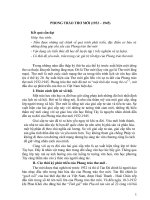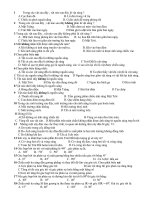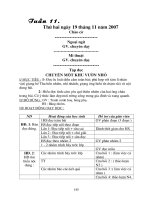FIBONACCI TRADING CỰC HAY
Bạn đang xem bản rút gọn của tài liệu. Xem và tải ngay bản đầy đủ của tài liệu tại đây (14.06 MB, 321 trang )
FIBONACCI
TRADING
This page intentionally left blank
F IBONACCI
TRADING
How to Master the
Time and Price Advantage
C A R O LY N B O R O D E N
New York Chicago San Francisco Lisbon
London Madrid Mexico City Milan New Delhi
San Juan Seoul Singapore Sydney Toronto
Copyright © 2008 by Carolyn Boroden. All rights reserved. Manufactured in the United States of America. Except as permitted
under the United States Copyright Act of 1976, no part of this publication may be reproduced or distributed in any form or by any
means, or stored in a database or retrieval system, without the prior written permission of the publisher.
0-07-159673-9
The material in this eBook also appears in the print version of this title: 0-07-149815-X.
All trademarks are trademarks of their respective owners. Rather than put a trademark symbol after every occurrence of a
trademarked name, we use names in an editorial fashion only, and to the benefit of the trademark owner, with no intention of
infringement of the trademark. Where such designations appear in this book, they have been printed with initial caps.
McGraw-Hill eBooks are available at special quantity discounts to use as premiums and sales promotions, or for use in corporate
training programs. For more information, please contact George Hoare, Special Sales, at or (212)
904-4069.
TERMS OF USE
This is a copyrighted work and The McGraw-Hill Companies, Inc. (“McGraw-Hill”) and its licensors reserve all rights in and to the
work. Use of this work is subject to these terms. Except as permitted under the Copyright Act of 1976 and the right to store and
retrieve one copy of the work, you may not decompile, disassemble, reverse engineer, reproduce, modify, create derivative works
based upon, transmit, distribute, disseminate, sell, publish or sublicense the work or any part of it without McGraw-Hill’s prior
consent. You may use the work for your own noncommercial and personal use; any other use of the work is strictly prohibited. Your
right to use the work may be terminated if you fail to comply with these terms.
THE WORK IS PROVIDED “AS IS.” McGRAW-HILL AND ITS LICENSORS MAKE NO GUARANTEES OR WARRANTIES
AS TO THE ACCURACY, ADEQUACY OR COMPLETENESS OF OR RESULTS TO BE OBTAINED FROM USING THE
WORK, INCLUDING ANY INFORMATION THAT CAN BE ACCESSED THROUGH THE WORK VIA HYPERLINK OR OTHERWISE, AND EXPRESSLY DISCLAIM ANY WARRANTY, EXPRESS OR IMPLIED, INCLUDING BUT NOT LIMITED TO
IMPLIED WARRANTIES OF MERCHANTABILITY OR FITNESS FOR A PARTICULAR PURPOSE. McGraw-Hill and its
licensors do not warrant or guarantee that the functions contained in the work will meet your requirements or that its operation will
be uninterrupted or error free. Neither McGraw-Hill nor its licensors shall be liable to you or anyone else for any inaccuracy, error
or omission, regardless of cause, in the work or for any damages resulting therefrom. McGraw-Hill has no responsibility for the
content of any information accessed through the work. Under no circumstances shall McGraw-Hill and/or its licensors be liable for
any indirect, incidental, special, punitive, consequential or similar damages that result from the use of or inability to use the work,
even if any of them has been advised of the possibility of such damages. This limitation of liability shall apply to any claim or cause
whatsoever whether such claim or cause arises in contract, tort or otherwise.
DOI: 10.1036/007149815X
Professional
Want to learn more?
We hope you enjoy this
McGraw-Hill eBook! If
you’d like more information about this book,
its author, or related books and websites,
please click here.
For more information about this title, click here
CONTENTS
FOREWORD vii
ACKNOWLEDGMENTS
INTRODUCTION xi
ix
Chapter 1:
Fibonacci Numbers and the Golden Ratio
1
Chapter 2:
Applying Fibonacci Ratios to the Price Axis of the Market
Chapter 3:
Fibonacci Price Retracements
9
Chapter 4:
Fibonacci Price Extensions
29
Chapter 5:
Fibonacci Price Projections or Objectives
45
Chapter 6:
Fibonacci Price Cluster Setups: Trade Setup 1
61
Chapter 7:
Symmetry—The Power Tool: Trade Setup 2
v
97
5
vi
Contents
Chapter 8:
The Two-Step Pattern Setup: Trade Setup 3 127
Chapter 9:
Choosing the Swings for Analysis 147
Chapter 10:
Applying Fibonacci Ratios on the Time Axis of the Market 157
Chapter 11:
Fibonacci Time Clusters 175
Chapter 12:
Using Dynamic Trader Time Projection Reports and Histograms 193
Chapter 13:
Time and Price Confluence 205
Chapter 14:
Triggers and Indicators 217
Chapter 15:
The Ideal Trade Setup 247
Chapter 16:
From Analysis to Trade Entry—Putting It All Together 269
Chapter 17:
Beating the Odds with a Trading Plan 285
INDEX 295
FOREWORD
Most traders have been exposed to some aspect of what we call Fibonacci
trading, mostly in reference to Fibonacci price retracements. Traders have
been using these retracements for years to help identify them price support and resistance. But Fibonacci retracements are just a beginner’s application of these important ratios for trading. It is how you use them in
different trading situations that is important. In addition, there are other
geometric and harmonic ratios that are equally important that you will
learn about in this book.
What most traders have never been taught is how to use these ratios
for support and resistance time targets in the same manner as they are
used for price targets. When you combine Fibonacci time and price projections as part of a trading plan, you should have a powerful approach to
identifying trade opportunities. I don’t think there is anyone who is more
qualified to teach you about Fibonacci time and price trading strategies
than the FibQueen herself (aka Carolyn Boroden).
I first met Carolyn in 1989 at the first Gann-Elliott Magazine (since
evolved into Traders World magazine) conference in Chicago. She was one
of the first people to study my Gann Home Study Trading Course, which
was first released at that conference. But she wasn’t new to the financial
markets and trading in 1989. Unlike most trading educators, Carolyn
has spent her entire adult life working with the financial markets, from
floor runner as a teenager to fund advisor to day-trading mentor. While
she has been a relentless student of the markets, she has also had years of
practical experience in almost every phase of the trading business.
vii
Copyright © 2008 by Carolyn Boroden. Click here for terms of use.
viii
Foreword
We kept in contact for several years after 1989, faxing charts, analysis,
and trade strategies back and forth between Tucson and Chicago. In 1993,
I convinced her to move to Tucson to work with me. She was soon wooed
away by an offer to provide analysis and trade strategies for a fund for a
whole lot more money than I was paying her, but we have remained
friends and associates ever since.
She has been a student of my Dynamic Trading methods for almost
20 years and has used my Dynamic Trading software, which you will see
in this book, since Version 1 was released in 1997. There is no better example of a relationship in which the “student becomes the teacher” than that
of Carolyn and me. In recent years, I’ve learned as much from her as she
did from me in the early years, especially about her symmetry setups and
trade strategies, which you will learn in this book.
I’m very proud to have been her mentor in the early years and her
friend forever, and I know that her book, which you hold in your hands,
will be one of your most valuable reference books for your business of
trading.
ROBERT MINER
Dynamic Traders Group, Inc.
Steamboat Springs, CO
ACKNOWLEDGMENTS
I would like to thank my many teachers over the years. First, my mentor,
Robert Miner, whom I met at a conference at the Midland Hotel in Chicago
just after the market crash of 1987. Others who have contributed to my education over the years include Robert Krausz (who talked me into going to
the conference where I met my mentor), Larry Pesavento, Bryce Gilmore,
David Patterson, Mark Douglas, and Woodie of woodiescciclub.com.
Thank you to my new business associates John Carter and Hubert
Senters and the Tradethemarkets.com team for their help and support in
marketing and growing my business.
I would like to thank Richard Karst, aka (RMK), for backing me up
in my chat room so that I could sometimes have a life! Thank you,
John Haytol, for the computer advice and the vision of a virtual chat room
with live charts. I would also like to thank Todd Phillips for helping me
implement this vision with computer screen-sharing technologies that
have forever changed my chat room. Thanks to Dennis Bolze and Richard
Lowrance for believing in me and supporting my work. Thanks to my
friend Joe Nicholas of Hedge Fund Research, who must have thought
I had “something going on,” since he kept a business file on me! Thank
you, William M. Kidder, aka “Uncle Bill,” for giving me a chance to prove
myself at DLJ when I was 18 at my first job on Wall Street.
I would also like to acknowledge my friend and client Dr. Firouz
Amirparviz, who left us in December 2004. I want to thank him and his
family for treating me as if I were part of their family, or, as he called it, for
“adapting” me.
ix
Copyright © 2008 by Carolyn Boroden. Click here for terms of use.
x
Acknowledgments
Last but not least, I would like to thank the entire King family for
their love and support, especially during the task of writing this book.
After all, a Queen needs her Kings! This family truly helped me keep my
sanity when I overworked myself—almost to the brink of a nervous breakdown. Love you all!
CB
aka Fibonacci Queen
INTRODUCTION
My purpose in writing this book is to give you an introduction to the
fascinating world of Fibonacci. It is also to provide you with a very specific
trading methodology that can be added to your current list of strategies.
For me, this method has continued to identify key trading opportunities in
the markets since 1989, and it has never failed me.
Chapter 1 will introduce you to the Fibonacci numbers and the
Golden Ratio—the backbone of this methodology. Chapters 2 through
9 will take you through the steps of using Fibonacci on the price axis of
the market, including the trade setups that are created with this work.
(These are the trade setups that I provide for my clients every day in my
live chat room.)
Chapters 10 to 13 explain how to apply Fibonacci to the time axis of
the market and then combine this with the price work to find the highestprobability trade setups. Chapters 14 to 16 will help you fine-tune your
market entries, ending with an example of a trade setup from analysis
to entry. Last but not least, Chapter 17 focuses on trading psychology,
discipline, money management, and the importance of having a written
trading plan. (The proper psychology will allow you to implement your
trading plan, with the discipline to follow the plan along with proper
money management techniques.)
Like having a good starting hand in a game of Texas Hold ’Em, this
book will teach you how to stack the market odds in your favor.
xi
Copyright © 2008 by Carolyn Boroden. Click here for terms of use.
This page intentionally left blank
FIBONACCI
TRADING
This page intentionally left blank
1
C H A P T E R
FIBONACCI NUMBERS AND
THE GOLDEN RATIO
For those who are not already familiar with the name Fibonacci, you may
remember hearing something about it in 2006, when the movie The DaVinci
Code appeared in theaters. When Jacques Saunière was found murdered
at the Louvre Museum in Paris, the strange position that this deceased
character was placed in mimicked the famous painting of the Vitruvian
Man by Leonardo da Vinci. This painting has been known to illustrate how
Fibonacci ratios appear in the human form. The film also piqued the
curiosity of some people when the characters in the film started talking
about Fibonacci numbers as part of a clue or code of some sort. For myself,
I only chuckled and thought, “It’s about time someone is taking Fibonacci
seriously.”
The Fibonacci number series and the properties of this series were
made famous by the Italian mathematician Leonardo de Pisa. The Fibonacci
number series starts with 0 and 1 and goes out to infinity, with the next
number in the series being derived by adding the prior two. For example,
55 + 89 = 144, 89 + 144 = 233, 144 + 233 = 377, and so on (see the following
number series):
0, 1, 1, 2, 3, 5, 8, 13, 21, 34, 55, 89, 144, 233, 377, 610, 987 . . . out to infinity
What is most fascinating about this number series is that there is a
constant found within the series as it progresses toward infinity. In the
relationship between the numbers in the series, you will find that the ratio
is 1.618, or what is called the Golden Ratio, Golden Mean, or Golden or
1
Copyright © 2008 by Carolyn Boroden. Click here for terms of use.
Fibonacci Trading: How to Master the Time and Price Advantage
Divine Proportion. (For example, 55 x 1.618 = 89, and 144 is 1.618 times 89.)
Take any two consecutive numbers in the series after you get beyond the
first few and you will find the Golden Ratio. Also note that the inverse or
reciprocal of 1.618 is 0.618.
There are quite a few Web sites that are devoted to this number series
and its properties. Just type the word Fibonacci into your favorite search
engine and you’ll be amazed at the wealth of information that exists on
this subject.
The Golden Ratio can be found in many different places. The 1.618
ratio is used in architecture in what is called the “golden rectangle,” as it
is known to be pleasing to the eye. There are actually plastic surgeons who
use these ratios to help them sculpt faces of “perfect proportion.” You can
also find the ratio in nature. It can be seen in flowers, the nautilus shell,
ammonite fossils, and many other places. What I find to be most fascinating is that this ratio shows up in the pentagram (see Figure 1-1), which is
known as a symbol for hidden occult knowledge. It occurred to me that
maybe the ratio within the pentagram held a hidden secret to the market!
At one point in my education, I actually studied Jewish mysticism.
One of my teachers from a Golden Dawn temple in California handed me
a copy of a Disney cartoon called “Donald in Mathmagic Land,” saying
that I might enjoy it. Another student had brought it to his attention,
as Donald Duck had a pentagram inscribed on his hand in this Disney
cartoon. In this cartoon, which was produced to teach children about
math, Donald Duck was on an adventure in Mathmagic land, where
1.00
FIGURE
.618
1-1
2
Fibonacci Numbers and the Golden Ratio
he visited with Plato and Pythagoras, talked about “secret mathematical
societies,” and learned about the Golden Section. The cartoon illustrated
where the ratios of 0.618 and 1.618 exist in nature and architecture. This
cartoon, which Disney released in 1959, is still available via the Internet,
and it is well worth watching. The quote at the end of the cartoon was from
Galileo, “Mathematics is the alphabet in which God has written the
universe.” I believe this to be true. If you study the “code” of the Fibonacci
numbers and the ratios derived from this number series long enough,
I think you will begin to agree with, or at least understand, that statement.
This is not something that should just be blindly accepted because I have
found it to be true. It is something that you must discover and then prove
to yourself on your own journey!
What is important to most traders is that applying these ratios can
help identify key support and resistance zones in the market, and therefore
determine key trading opportunities or setups. I will show you how to
apply these ratios in any market with adequate data. Thus, the application
can give you a huge edge as a trader, if you use the techniques properly.
3
This page intentionally left blank
2
C H A P T E R
APPLYING FIBONACCI
RATIOS TO THE PRICE
AXIS OF THE MARKET
W
e will not use the Fibonacci number series to analyze the markets.
Instead, we will use the ratios derived from this number series. We’ve
already discussed 1.618 and 0.618 or the Golden Ratio and its inverse. The
main ratios I use in my everyday analysis are 0.382, 0.50, 0.618, 0.786, 1.00,
1.272, and 1.618.
I will sometimes also include 0.236, 2.618, and 4.236.
In Chapter 1, you saw how we found the 0.618 and 1.618 ratios within
the Fibonacci number series, but what about the rest of these ratios? Well,
actually, they are all related mathematically.
For example:
1.0 Ϫ 0.618 = 0.382
0.618 ϫ 0.618 = 0.382
1.0 Ϭ 2 = 0.50
Square root of 0.618 = 0.786
0.618 is the reciprocal of 1.618
Square root of 1.618 = 1.272
0.618 Ϫ 0.382 = 0.236
0.382 ϫ 0.618 = 0.236
1.618 ϫ 1.618 = 2.618
2.618 ϫ 1.618 = 4.236
Now what do we do with these ratios and how do they help us trade?
5
Copyright © 2008 by Carolyn Boroden. Click here for terms of use.
Fibonacci Trading: How to Master the Time and Price Advantage
We will find our trade setups or trading opportunities by applying
the main Fibonacci ratios on the price axis of the market. There are three
basic trade setups that I use in my chat room every day: (1) price cluster
setups, (2) symmetry setups, and (3) two-step pattern setups.
Author Tip
This type of Fibonacci price analysis can work well in any
market and pretty much on any time frame, as long as there
is adequate data and you can identify key swing highs and lows on the chart.
Do not attempt to use this type of analysis on something like a penny stock,
where you can’t identify any meaningful swings, or in a market with minimal data
available. In such cases, this technique will have no value.
TOOLS OF THE TRADE
Since you are looking into this type of technical analysis, I am assuming that
you have a computer; a market data source such as e-signal, quote.com,
or Genesis Financial data; and a technical analysis program to manipulate
the data. You can do some of this work by hand with paper charts and a
calculator or a proportional divider, although it is tedious and not practical.
(While I started the technical analysis phase of my career using those oldfashioned tools, I do not recommend that to anyone, given all the wonderful
technology that is available today.)
The technical analysis program that I primarily use to run my time
and price work is Dynamic Trader, with an e-signal feed as my data
source. There are other programs that will run at least the price analysis
work, though there are only a few that have both the proper price and
time tools you will need if you choose to analyze both dimensions of
the market.
Unless otherwise specified, most of the chart examples in this book
are produced with the Dynamic Trader software. Also note that some of
the charts may appear “fuzzy,” or you may feel that you can’t read the
prices very clearly. Don’t worry; I did not use a bad graphics program to
capture these chart illustrations. This happens because the price relationships are clustering and essentially overlapping one another, making the
chart levels difficult to read. This is something that we actually want to see
happen. This will all make sense to you by the time you get through the
first half of this book.
6
Applying Fibonacci Ratios to the Price Axis of the Market
FIBONACCI PRICE RELATIONSHIPS
We start by running three different types of Fibonacci price relationships
to find our trade setups. These are retracements, extensions, and price projections (sometimes called price objectives). First we will look at each of these
types of price relationship individually. Later, we will be putting them
together while we look for our trade setups. Each of these price relationships will be setting up potential support or potential resistance in the chart
you are analyzing.
The definition of support is a price area below the current market
where you will look for the possible termination of a decline and where
you would consider being a buyer of whatever market you are analyzing.
You might be looking to buy at or around support either to initiate a new
trade on the long side or to exit a short position if you think the support
may hold and the market won’t decline any further.
The definition of resistance is a price area above the current market
where you would look for the possible termination of a rally and consider
being a seller. You might be looking to sell at or around resistance to initiate a new trade on the short side or to exit a long position if you think the
resistance may hold and the market won’t go any higher.
In the next three chapters, you will discover the types of price relationships that are necessary for running your analysis. Please do not get
overwhelmed with the information I am presenting throughout this book.
Be patient with yourself. If you start by applying one concept at a time,
you will be well rewarded for your perseverance.
7
This page intentionally left blank
3
C H A P T E R
FIBONACCI PRICE
RETRACEMENTS
Fibonacci price retracements are run from a prior low-to-high swing using
the ratios 0.382, 0.50, 0.618, and 0.786 (0.236 is also used in some cases
if the swing is relatively long) to identify possible support levels as the
market pulls back from a high. Retracements are also run from a prior
high-to-low swing using these same ratios, looking for possible resistance
as the market bounces from a low.
Most basic technical analysis packages will run the retracement levels
for you when you choose the swing you want to run them from and select
the proper Fibonacci price tool within the program you are using. If you
want to understand the math, however, multiply the length of the swing
(from low to high or from high to low) by the retracement ratios and then
subtract the results from the high if you are running low-to-high swings,
or add the results to the low when you are running high-to-low swings.
9
Copyright © 2008 by Carolyn Boroden. Click here for terms of use.









